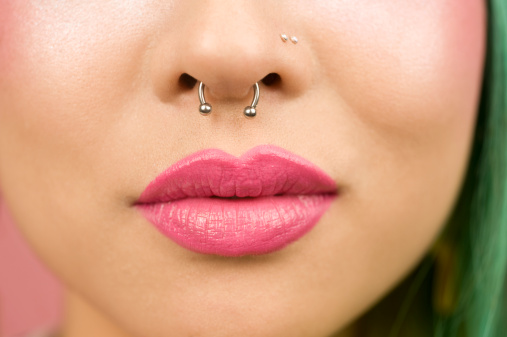Whether you’ve pierced your ears, nose, bellybutton or any other body part, infection is a threat to the healing process. Even before the needle first pokes your skin, preventative measures are taken to keep the risk of contracting one low. The area is swabbed with alcohol, the needle is stainless or hospital-grade steel and latex gloves are worn by the piercer, all as a way to ward off bacteria.
After your piercing is done and you’re allowed to marvel at the new bling twinkling back in your reflection, the piercer will give you a series of instructions to continue the path of germ protection as the hole heals. Each body part heals differently, so be patient with the process. An earlobe may only take six weeks where as the ear cartilage can take up to nine months.
If your best efforts couldn’t prevent the dreaded infection, there’s no need to worry since it’s treatable. Whatever you do, don’t remove the piercing without consulting your piercer. In the beginning months, removing a piercing can close the hole in as few as two hours. When the wound closes, the infection is trapped inside and will create an abscess, making it difficult for drainage.
The most common infection is the infamous bubble. It is a small, red or white raised bump (similar to a pimple) next to the piercing caused by either trauma or dirt and bacteria. It may look awful and feel tender, but it’s one of the easiest to get rid of. First, soak the area with warm water either by dunking the area in a bowl or using a washcloth as a compress. This will soften the flesh and help draw up the pus or discharge. Then mix a little sea salt (absolutely no table salt) in warm water to create a paste. Use a Q-tip or cotton ball to apply the mixture to the area and leave on for 15 minutes. This can be repeated 2-3 times per day until the infection has vanished.
Of course, if your infection is more severe, causing a large amount of pain, or you’re running a fever, make an appointment to see your doctor. A course of antibiotics may be necessary.
Clinton Keyser of Urban X-Change from the Patrick Henry Mall in Newport News, Va. recommends the following tips for taking care of your piercing.
- Don’t twist your piercing as that can cause further trauma
- Don’t use antibiotic creams such as Neosporin. The main ingredient in these products is petroleum jelly which is not to be used on puncture wounds.
- Bellybutton piercings are the most vulnerable to infections because of sweat and movement, so watch closely.
- Try to avoid touching your piercing as much as possible. If you do touch it, always wash your hands first.







